Rules Club Wagga Hotel: A Modern Construction Project Case Study
VerifiedAdded on 2023/01/19
|15
|3138
|56
Report
AI Summary
This report presents a detailed case study of the Rules Club Wagga Hotel project, constructed by Modular Building Systems Company (MBS). The project, a four-star, 75-room hotel, utilized a modular construction process involving design, component assembly, shipment, and erection. The report highlights the characteristics of MBS, the project's description, problems encountered (financial, schedule, structural, and design), and the innovations implemented, specifically diagonal braces and double modular walls. The study further explores the outcomes of these innovations, including improved insulation, acoustic benefits, and seismic performance, as well as potential areas for improvement. The analysis underscores the efficiency and innovation of modular construction in modern building projects, providing valuable insights into the challenges and benefits of this construction method.
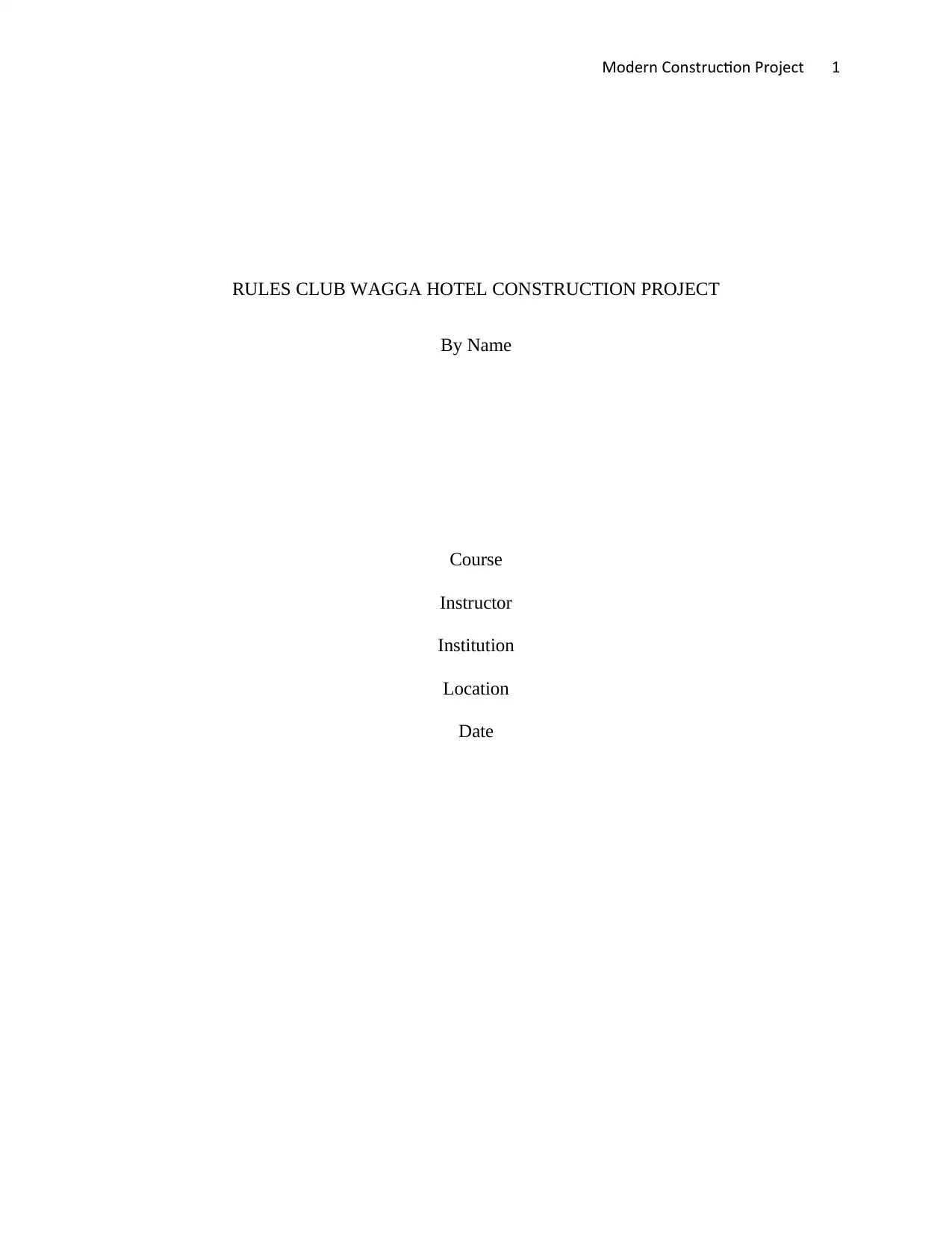
Modern Construction Project 1
RULES CLUB WAGGA HOTEL CONSTRUCTION PROJECT
By Name
Course
Instructor
Institution
Location
Date
RULES CLUB WAGGA HOTEL CONSTRUCTION PROJECT
By Name
Course
Instructor
Institution
Location
Date
Paraphrase This Document
Need a fresh take? Get an instant paraphrase of this document with our AI Paraphraser
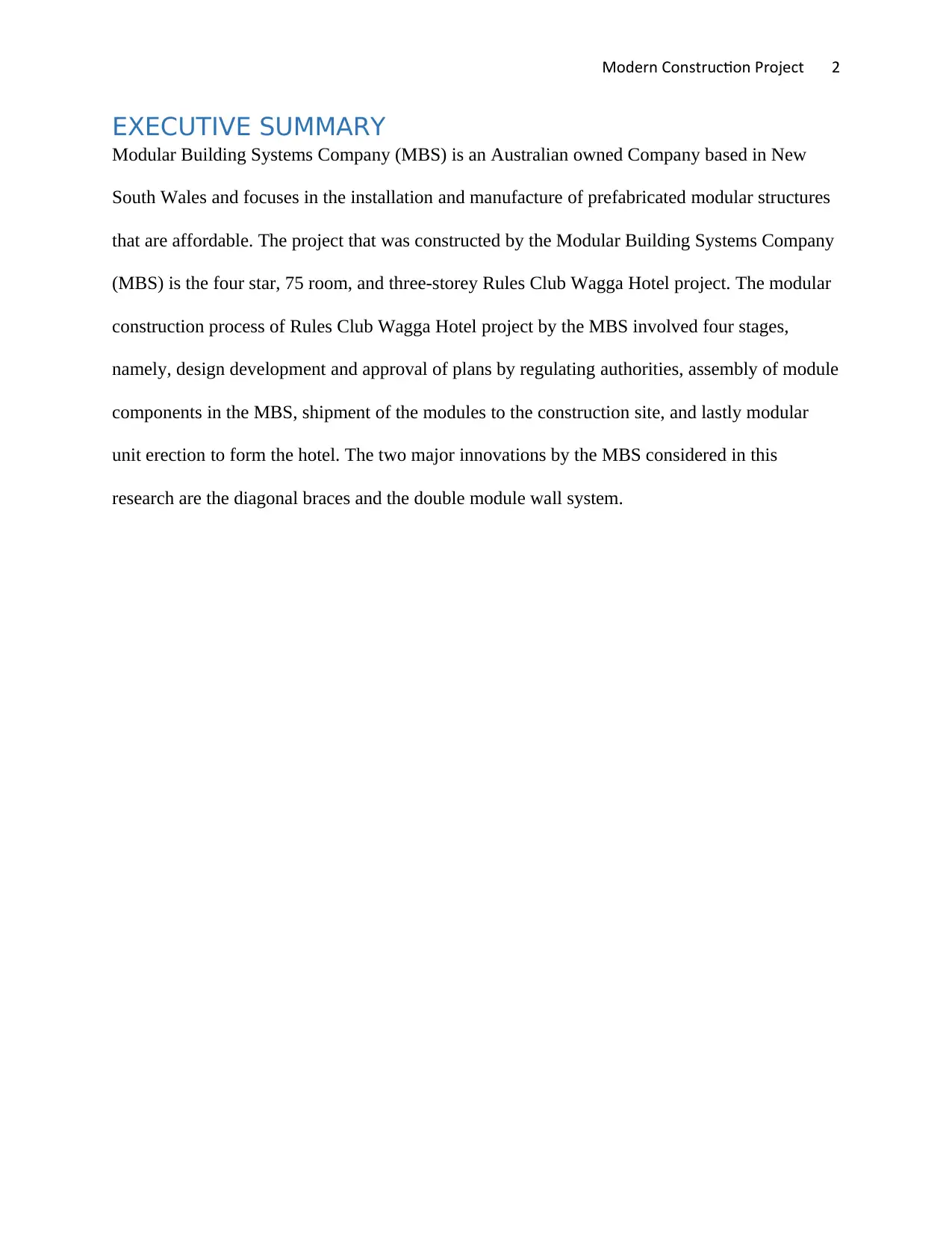
Modern Construction Project 2
EXECUTIVE SUMMARY
Modular Building Systems Company (MBS) is an Australian owned Company based in New
South Wales and focuses in the installation and manufacture of prefabricated modular structures
that are affordable. The project that was constructed by the Modular Building Systems Company
(MBS) is the four star, 75 room, and three-storey Rules Club Wagga Hotel project. The modular
construction process of Rules Club Wagga Hotel project by the MBS involved four stages,
namely, design development and approval of plans by regulating authorities, assembly of module
components in the MBS, shipment of the modules to the construction site, and lastly modular
unit erection to form the hotel. The two major innovations by the MBS considered in this
research are the diagonal braces and the double module wall system.
EXECUTIVE SUMMARY
Modular Building Systems Company (MBS) is an Australian owned Company based in New
South Wales and focuses in the installation and manufacture of prefabricated modular structures
that are affordable. The project that was constructed by the Modular Building Systems Company
(MBS) is the four star, 75 room, and three-storey Rules Club Wagga Hotel project. The modular
construction process of Rules Club Wagga Hotel project by the MBS involved four stages,
namely, design development and approval of plans by regulating authorities, assembly of module
components in the MBS, shipment of the modules to the construction site, and lastly modular
unit erection to form the hotel. The two major innovations by the MBS considered in this
research are the diagonal braces and the double module wall system.
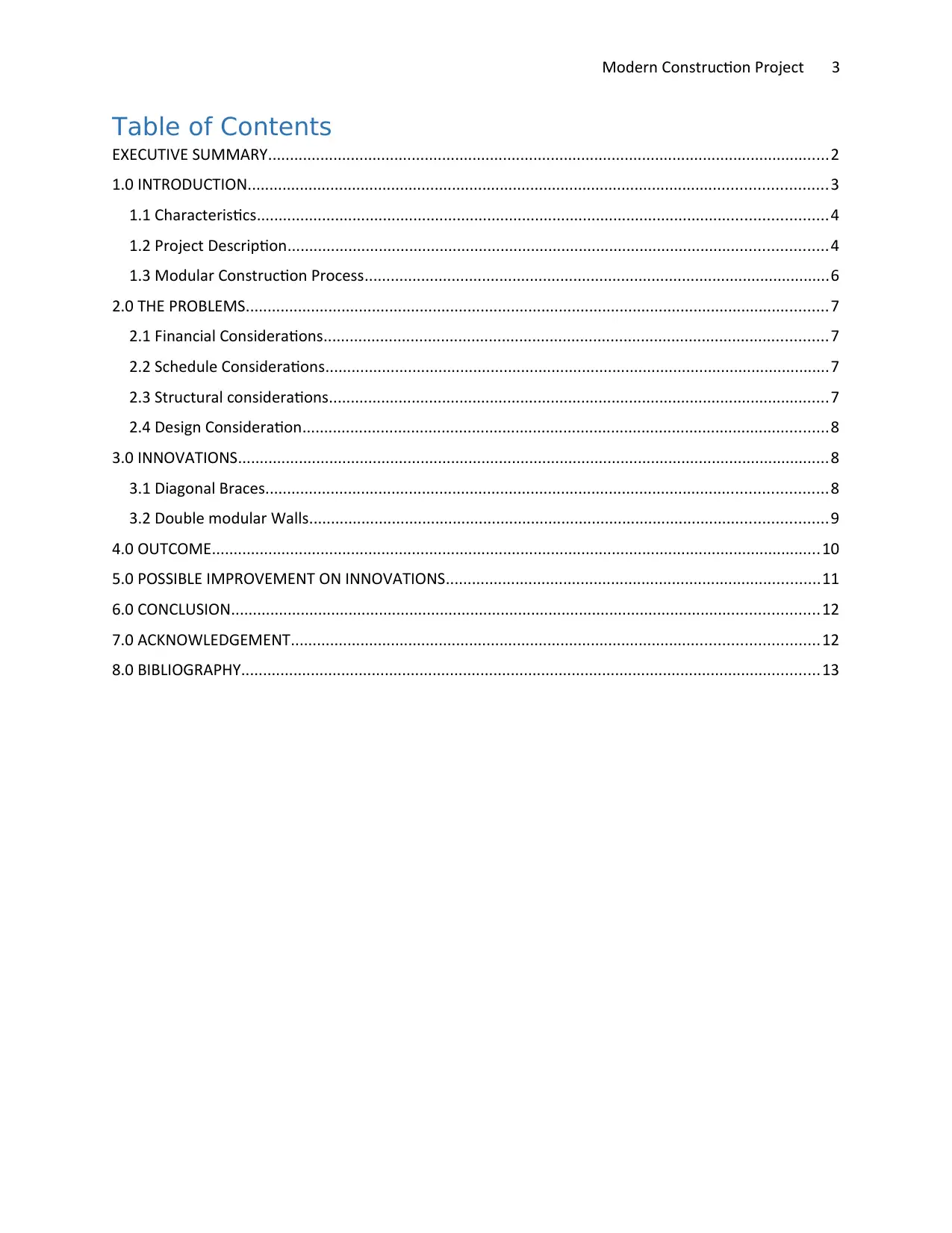
Modern Construction Project 3
Table of Contents
EXECUTIVE SUMMARY.................................................................................................................................2
1.0 INTRODUCTION.....................................................................................................................................3
1.1 Characteristics...................................................................................................................................4
1.2 Project Description............................................................................................................................4
1.3 Modular Construction Process...........................................................................................................6
2.0 THE PROBLEMS......................................................................................................................................7
2.1 Financial Considerations....................................................................................................................7
2.2 Schedule Considerations....................................................................................................................7
2.3 Structural considerations...................................................................................................................7
2.4 Design Consideration.........................................................................................................................8
3.0 INNOVATIONS........................................................................................................................................8
3.1 Diagonal Braces.................................................................................................................................8
3.2 Double modular Walls.......................................................................................................................9
4.0 OUTCOME............................................................................................................................................10
5.0 POSSIBLE IMPROVEMENT ON INNOVATIONS......................................................................................11
6.0 CONCLUSION.......................................................................................................................................12
7.0 ACKNOWLEDGEMENT.........................................................................................................................12
8.0 BIBLIOGRAPHY.....................................................................................................................................13
Table of Contents
EXECUTIVE SUMMARY.................................................................................................................................2
1.0 INTRODUCTION.....................................................................................................................................3
1.1 Characteristics...................................................................................................................................4
1.2 Project Description............................................................................................................................4
1.3 Modular Construction Process...........................................................................................................6
2.0 THE PROBLEMS......................................................................................................................................7
2.1 Financial Considerations....................................................................................................................7
2.2 Schedule Considerations....................................................................................................................7
2.3 Structural considerations...................................................................................................................7
2.4 Design Consideration.........................................................................................................................8
3.0 INNOVATIONS........................................................................................................................................8
3.1 Diagonal Braces.................................................................................................................................8
3.2 Double modular Walls.......................................................................................................................9
4.0 OUTCOME............................................................................................................................................10
5.0 POSSIBLE IMPROVEMENT ON INNOVATIONS......................................................................................11
6.0 CONCLUSION.......................................................................................................................................12
7.0 ACKNOWLEDGEMENT.........................................................................................................................12
8.0 BIBLIOGRAPHY.....................................................................................................................................13
⊘ This is a preview!⊘
Do you want full access?
Subscribe today to unlock all pages.

Trusted by 1+ million students worldwide
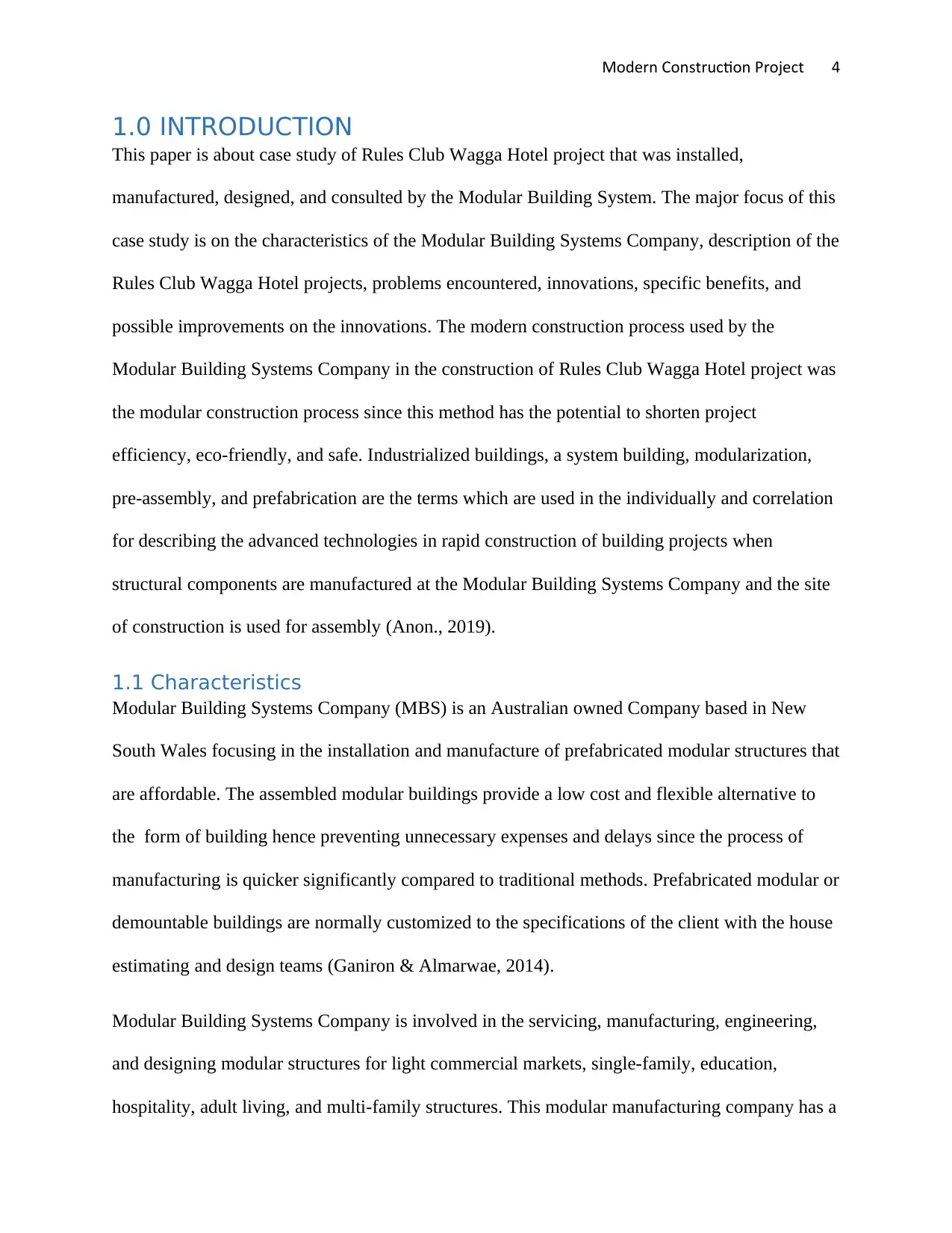
Modern Construction Project 4
1.0 INTRODUCTION
This paper is about case study of Rules Club Wagga Hotel project that was installed,
manufactured, designed, and consulted by the Modular Building System. The major focus of this
case study is on the characteristics of the Modular Building Systems Company, description of the
Rules Club Wagga Hotel projects, problems encountered, innovations, specific benefits, and
possible improvements on the innovations. The modern construction process used by the
Modular Building Systems Company in the construction of Rules Club Wagga Hotel project was
the modular construction process since this method has the potential to shorten project
efficiency, eco-friendly, and safe. Industrialized buildings, a system building, modularization,
pre-assembly, and prefabrication are the terms which are used in the individually and correlation
for describing the advanced technologies in rapid construction of building projects when
structural components are manufactured at the Modular Building Systems Company and the site
of construction is used for assembly (Anon., 2019).
1.1 Characteristics
Modular Building Systems Company (MBS) is an Australian owned Company based in New
South Wales focusing in the installation and manufacture of prefabricated modular structures that
are affordable. The assembled modular buildings provide a low cost and flexible alternative to
the form of building hence preventing unnecessary expenses and delays since the process of
manufacturing is quicker significantly compared to traditional methods. Prefabricated modular or
demountable buildings are normally customized to the specifications of the client with the house
estimating and design teams (Ganiron & Almarwae, 2014).
Modular Building Systems Company is involved in the servicing, manufacturing, engineering,
and designing modular structures for light commercial markets, single-family, education,
hospitality, adult living, and multi-family structures. This modular manufacturing company has a
1.0 INTRODUCTION
This paper is about case study of Rules Club Wagga Hotel project that was installed,
manufactured, designed, and consulted by the Modular Building System. The major focus of this
case study is on the characteristics of the Modular Building Systems Company, description of the
Rules Club Wagga Hotel projects, problems encountered, innovations, specific benefits, and
possible improvements on the innovations. The modern construction process used by the
Modular Building Systems Company in the construction of Rules Club Wagga Hotel project was
the modular construction process since this method has the potential to shorten project
efficiency, eco-friendly, and safe. Industrialized buildings, a system building, modularization,
pre-assembly, and prefabrication are the terms which are used in the individually and correlation
for describing the advanced technologies in rapid construction of building projects when
structural components are manufactured at the Modular Building Systems Company and the site
of construction is used for assembly (Anon., 2019).
1.1 Characteristics
Modular Building Systems Company (MBS) is an Australian owned Company based in New
South Wales focusing in the installation and manufacture of prefabricated modular structures that
are affordable. The assembled modular buildings provide a low cost and flexible alternative to
the form of building hence preventing unnecessary expenses and delays since the process of
manufacturing is quicker significantly compared to traditional methods. Prefabricated modular or
demountable buildings are normally customized to the specifications of the client with the house
estimating and design teams (Ganiron & Almarwae, 2014).
Modular Building Systems Company is involved in the servicing, manufacturing, engineering,
and designing modular structures for light commercial markets, single-family, education,
hospitality, adult living, and multi-family structures. This modular manufacturing company has a
Paraphrase This Document
Need a fresh take? Get an instant paraphrase of this document with our AI Paraphraser
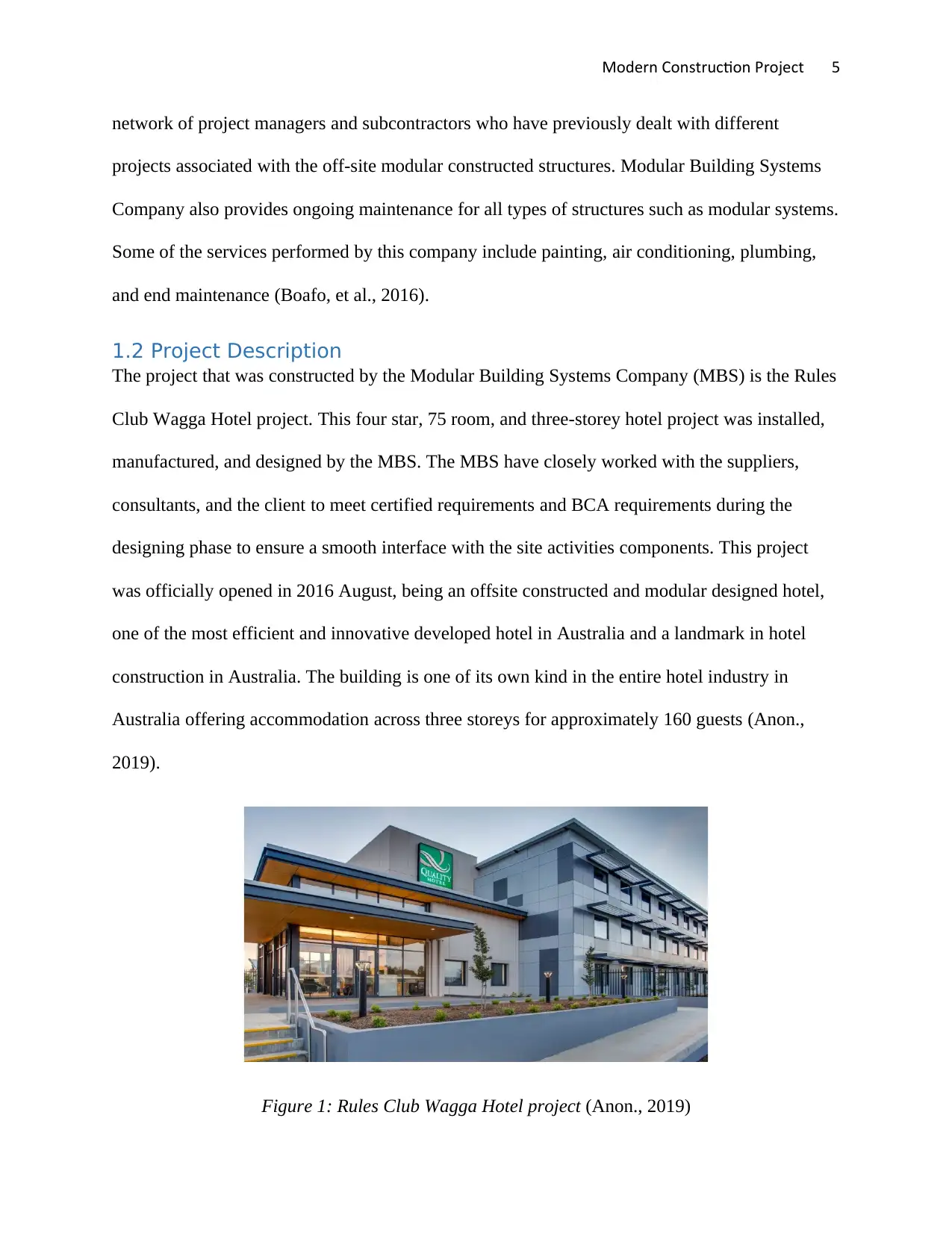
Modern Construction Project 5
network of project managers and subcontractors who have previously dealt with different
projects associated with the off-site modular constructed structures. Modular Building Systems
Company also provides ongoing maintenance for all types of structures such as modular systems.
Some of the services performed by this company include painting, air conditioning, plumbing,
and end maintenance (Boafo, et al., 2016).
1.2 Project Description
The project that was constructed by the Modular Building Systems Company (MBS) is the Rules
Club Wagga Hotel project. This four star, 75 room, and three-storey hotel project was installed,
manufactured, and designed by the MBS. The MBS have closely worked with the suppliers,
consultants, and the client to meet certified requirements and BCA requirements during the
designing phase to ensure a smooth interface with the site activities components. This project
was officially opened in 2016 August, being an offsite constructed and modular designed hotel,
one of the most efficient and innovative developed hotel in Australia and a landmark in hotel
construction in Australia. The building is one of its own kind in the entire hotel industry in
Australia offering accommodation across three storeys for approximately 160 guests (Anon.,
2019).
Figure 1: Rules Club Wagga Hotel project (Anon., 2019)
network of project managers and subcontractors who have previously dealt with different
projects associated with the off-site modular constructed structures. Modular Building Systems
Company also provides ongoing maintenance for all types of structures such as modular systems.
Some of the services performed by this company include painting, air conditioning, plumbing,
and end maintenance (Boafo, et al., 2016).
1.2 Project Description
The project that was constructed by the Modular Building Systems Company (MBS) is the Rules
Club Wagga Hotel project. This four star, 75 room, and three-storey hotel project was installed,
manufactured, and designed by the MBS. The MBS have closely worked with the suppliers,
consultants, and the client to meet certified requirements and BCA requirements during the
designing phase to ensure a smooth interface with the site activities components. This project
was officially opened in 2016 August, being an offsite constructed and modular designed hotel,
one of the most efficient and innovative developed hotel in Australia and a landmark in hotel
construction in Australia. The building is one of its own kind in the entire hotel industry in
Australia offering accommodation across three storeys for approximately 160 guests (Anon.,
2019).
Figure 1: Rules Club Wagga Hotel project (Anon., 2019)
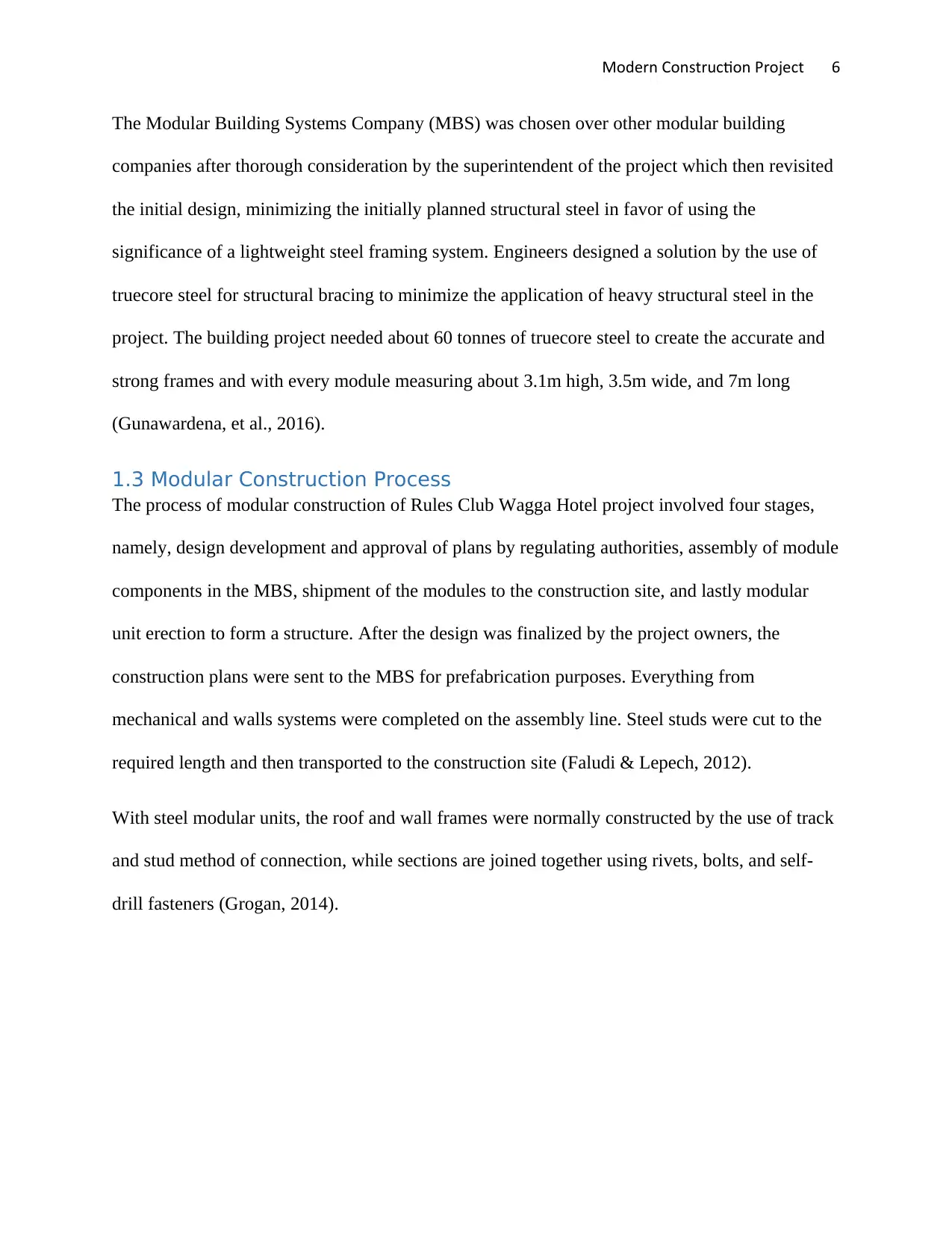
Modern Construction Project 6
The Modular Building Systems Company (MBS) was chosen over other modular building
companies after thorough consideration by the superintendent of the project which then revisited
the initial design, minimizing the initially planned structural steel in favor of using the
significance of a lightweight steel framing system. Engineers designed a solution by the use of
truecore steel for structural bracing to minimize the application of heavy structural steel in the
project. The building project needed about 60 tonnes of truecore steel to create the accurate and
strong frames and with every module measuring about 3.1m high, 3.5m wide, and 7m long
(Gunawardena, et al., 2016).
1.3 Modular Construction Process
The process of modular construction of Rules Club Wagga Hotel project involved four stages,
namely, design development and approval of plans by regulating authorities, assembly of module
components in the MBS, shipment of the modules to the construction site, and lastly modular
unit erection to form a structure. After the design was finalized by the project owners, the
construction plans were sent to the MBS for prefabrication purposes. Everything from
mechanical and walls systems were completed on the assembly line. Steel studs were cut to the
required length and then transported to the construction site (Faludi & Lepech, 2012).
With steel modular units, the roof and wall frames were normally constructed by the use of track
and stud method of connection, while sections are joined together using rivets, bolts, and self-
drill fasteners (Grogan, 2014).
The Modular Building Systems Company (MBS) was chosen over other modular building
companies after thorough consideration by the superintendent of the project which then revisited
the initial design, minimizing the initially planned structural steel in favor of using the
significance of a lightweight steel framing system. Engineers designed a solution by the use of
truecore steel for structural bracing to minimize the application of heavy structural steel in the
project. The building project needed about 60 tonnes of truecore steel to create the accurate and
strong frames and with every module measuring about 3.1m high, 3.5m wide, and 7m long
(Gunawardena, et al., 2016).
1.3 Modular Construction Process
The process of modular construction of Rules Club Wagga Hotel project involved four stages,
namely, design development and approval of plans by regulating authorities, assembly of module
components in the MBS, shipment of the modules to the construction site, and lastly modular
unit erection to form a structure. After the design was finalized by the project owners, the
construction plans were sent to the MBS for prefabrication purposes. Everything from
mechanical and walls systems were completed on the assembly line. Steel studs were cut to the
required length and then transported to the construction site (Faludi & Lepech, 2012).
With steel modular units, the roof and wall frames were normally constructed by the use of track
and stud method of connection, while sections are joined together using rivets, bolts, and self-
drill fasteners (Grogan, 2014).
⊘ This is a preview!⊘
Do you want full access?
Subscribe today to unlock all pages.

Trusted by 1+ million students worldwide
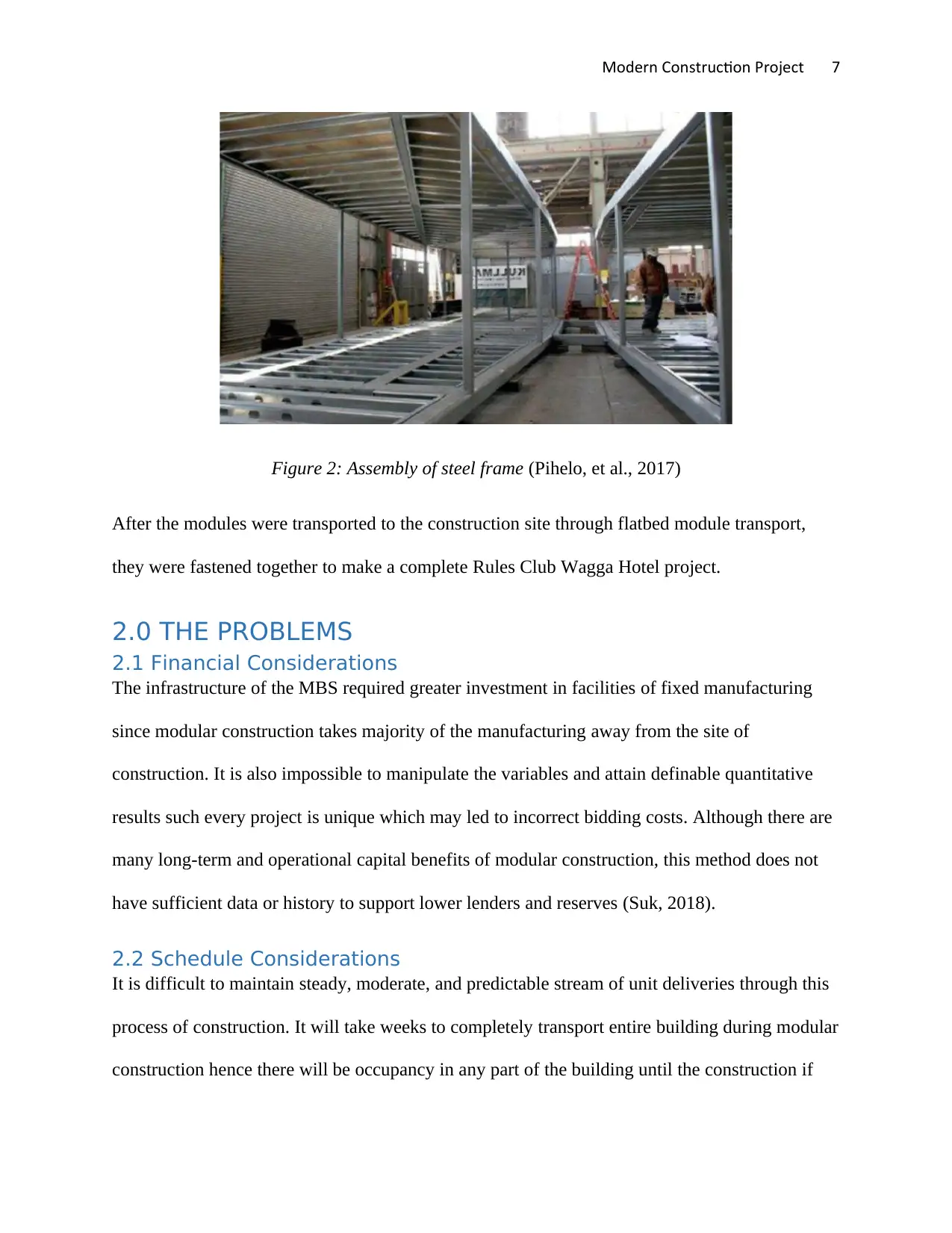
Modern Construction Project 7
Figure 2: Assembly of steel frame (Pihelo, et al., 2017)
After the modules were transported to the construction site through flatbed module transport,
they were fastened together to make a complete Rules Club Wagga Hotel project.
2.0 THE PROBLEMS
2.1 Financial Considerations
The infrastructure of the MBS required greater investment in facilities of fixed manufacturing
since modular construction takes majority of the manufacturing away from the site of
construction. It is also impossible to manipulate the variables and attain definable quantitative
results such every project is unique which may led to incorrect bidding costs. Although there are
many long-term and operational capital benefits of modular construction, this method does not
have sufficient data or history to support lower lenders and reserves (Suk, 2018).
2.2 Schedule Considerations
It is difficult to maintain steady, moderate, and predictable stream of unit deliveries through this
process of construction. It will take weeks to completely transport entire building during modular
construction hence there will be occupancy in any part of the building until the construction if
Figure 2: Assembly of steel frame (Pihelo, et al., 2017)
After the modules were transported to the construction site through flatbed module transport,
they were fastened together to make a complete Rules Club Wagga Hotel project.
2.0 THE PROBLEMS
2.1 Financial Considerations
The infrastructure of the MBS required greater investment in facilities of fixed manufacturing
since modular construction takes majority of the manufacturing away from the site of
construction. It is also impossible to manipulate the variables and attain definable quantitative
results such every project is unique which may led to incorrect bidding costs. Although there are
many long-term and operational capital benefits of modular construction, this method does not
have sufficient data or history to support lower lenders and reserves (Suk, 2018).
2.2 Schedule Considerations
It is difficult to maintain steady, moderate, and predictable stream of unit deliveries through this
process of construction. It will take weeks to completely transport entire building during modular
construction hence there will be occupancy in any part of the building until the construction if
Paraphrase This Document
Need a fresh take? Get an instant paraphrase of this document with our AI Paraphraser
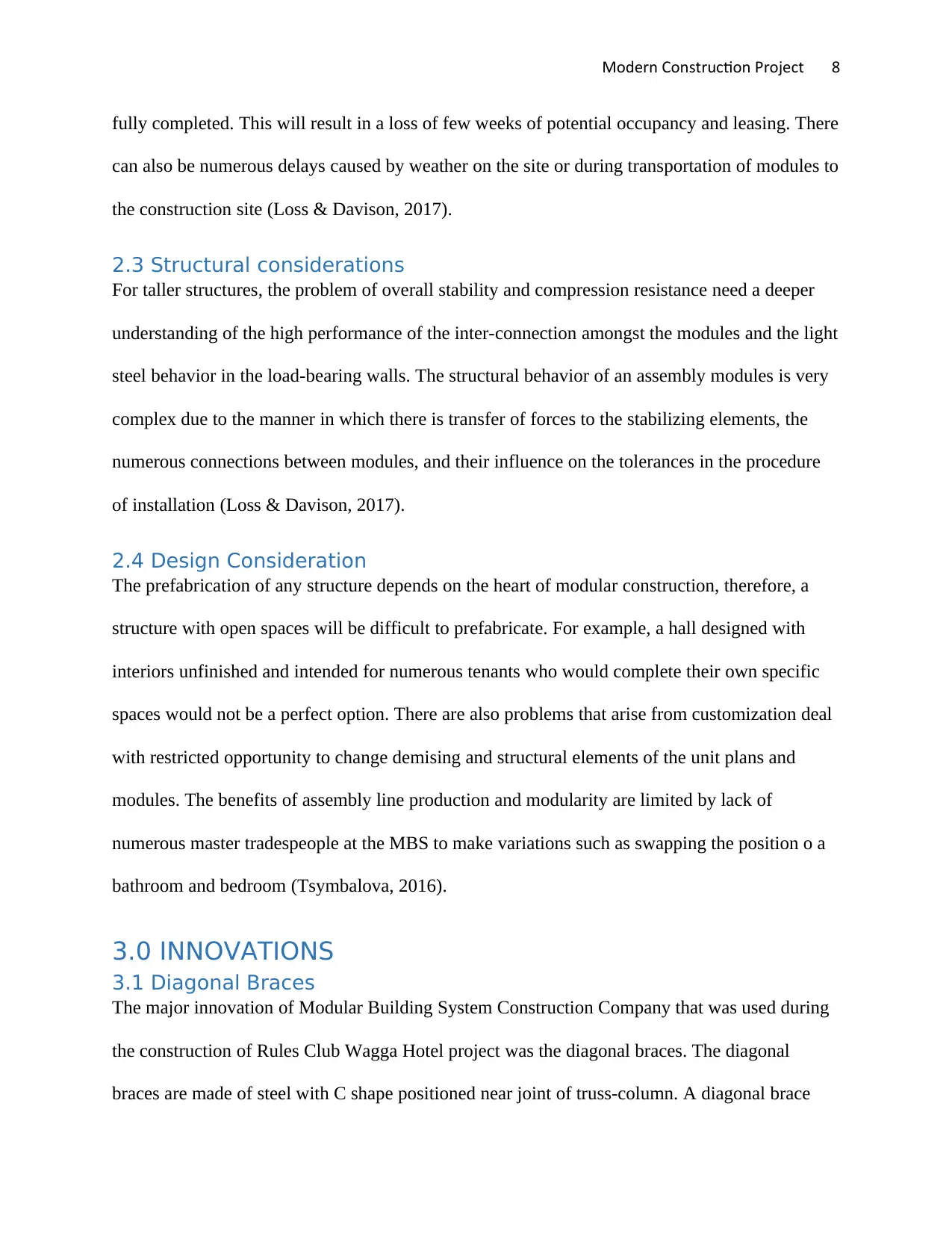
Modern Construction Project 8
fully completed. This will result in a loss of few weeks of potential occupancy and leasing. There
can also be numerous delays caused by weather on the site or during transportation of modules to
the construction site (Loss & Davison, 2017).
2.3 Structural considerations
For taller structures, the problem of overall stability and compression resistance need a deeper
understanding of the high performance of the inter-connection amongst the modules and the light
steel behavior in the load-bearing walls. The structural behavior of an assembly modules is very
complex due to the manner in which there is transfer of forces to the stabilizing elements, the
numerous connections between modules, and their influence on the tolerances in the procedure
of installation (Loss & Davison, 2017).
2.4 Design Consideration
The prefabrication of any structure depends on the heart of modular construction, therefore, a
structure with open spaces will be difficult to prefabricate. For example, a hall designed with
interiors unfinished and intended for numerous tenants who would complete their own specific
spaces would not be a perfect option. There are also problems that arise from customization deal
with restricted opportunity to change demising and structural elements of the unit plans and
modules. The benefits of assembly line production and modularity are limited by lack of
numerous master tradespeople at the MBS to make variations such as swapping the position o a
bathroom and bedroom (Tsymbalova, 2016).
3.0 INNOVATIONS
3.1 Diagonal Braces
The major innovation of Modular Building System Construction Company that was used during
the construction of Rules Club Wagga Hotel project was the diagonal braces. The diagonal
braces are made of steel with C shape positioned near joint of truss-column. A diagonal brace
fully completed. This will result in a loss of few weeks of potential occupancy and leasing. There
can also be numerous delays caused by weather on the site or during transportation of modules to
the construction site (Loss & Davison, 2017).
2.3 Structural considerations
For taller structures, the problem of overall stability and compression resistance need a deeper
understanding of the high performance of the inter-connection amongst the modules and the light
steel behavior in the load-bearing walls. The structural behavior of an assembly modules is very
complex due to the manner in which there is transfer of forces to the stabilizing elements, the
numerous connections between modules, and their influence on the tolerances in the procedure
of installation (Loss & Davison, 2017).
2.4 Design Consideration
The prefabrication of any structure depends on the heart of modular construction, therefore, a
structure with open spaces will be difficult to prefabricate. For example, a hall designed with
interiors unfinished and intended for numerous tenants who would complete their own specific
spaces would not be a perfect option. There are also problems that arise from customization deal
with restricted opportunity to change demising and structural elements of the unit plans and
modules. The benefits of assembly line production and modularity are limited by lack of
numerous master tradespeople at the MBS to make variations such as swapping the position o a
bathroom and bedroom (Tsymbalova, 2016).
3.0 INNOVATIONS
3.1 Diagonal Braces
The major innovation of Modular Building System Construction Company that was used during
the construction of Rules Club Wagga Hotel project was the diagonal braces. The diagonal
braces are made of steel with C shape positioned near joint of truss-column. A diagonal brace
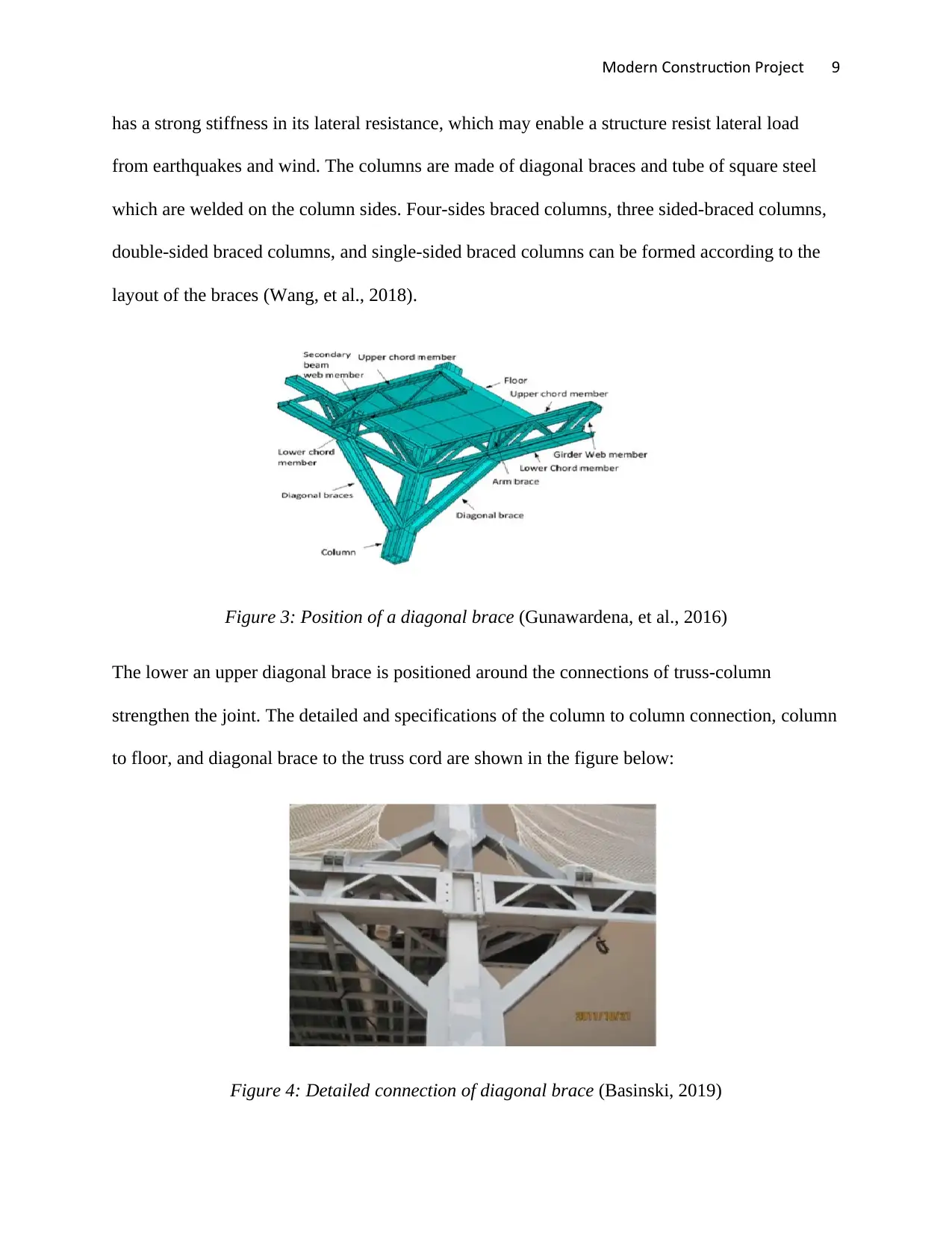
Modern Construction Project 9
has a strong stiffness in its lateral resistance, which may enable a structure resist lateral load
from earthquakes and wind. The columns are made of diagonal braces and tube of square steel
which are welded on the column sides. Four-sides braced columns, three sided-braced columns,
double-sided braced columns, and single-sided braced columns can be formed according to the
layout of the braces (Wang, et al., 2018).
Figure 3: Position of a diagonal brace (Gunawardena, et al., 2016)
The lower an upper diagonal brace is positioned around the connections of truss-column
strengthen the joint. The detailed and specifications of the column to column connection, column
to floor, and diagonal brace to the truss cord are shown in the figure below:
Figure 4: Detailed connection of diagonal brace (Basinski, 2019)
has a strong stiffness in its lateral resistance, which may enable a structure resist lateral load
from earthquakes and wind. The columns are made of diagonal braces and tube of square steel
which are welded on the column sides. Four-sides braced columns, three sided-braced columns,
double-sided braced columns, and single-sided braced columns can be formed according to the
layout of the braces (Wang, et al., 2018).
Figure 3: Position of a diagonal brace (Gunawardena, et al., 2016)
The lower an upper diagonal brace is positioned around the connections of truss-column
strengthen the joint. The detailed and specifications of the column to column connection, column
to floor, and diagonal brace to the truss cord are shown in the figure below:
Figure 4: Detailed connection of diagonal brace (Basinski, 2019)
⊘ This is a preview!⊘
Do you want full access?
Subscribe today to unlock all pages.

Trusted by 1+ million students worldwide
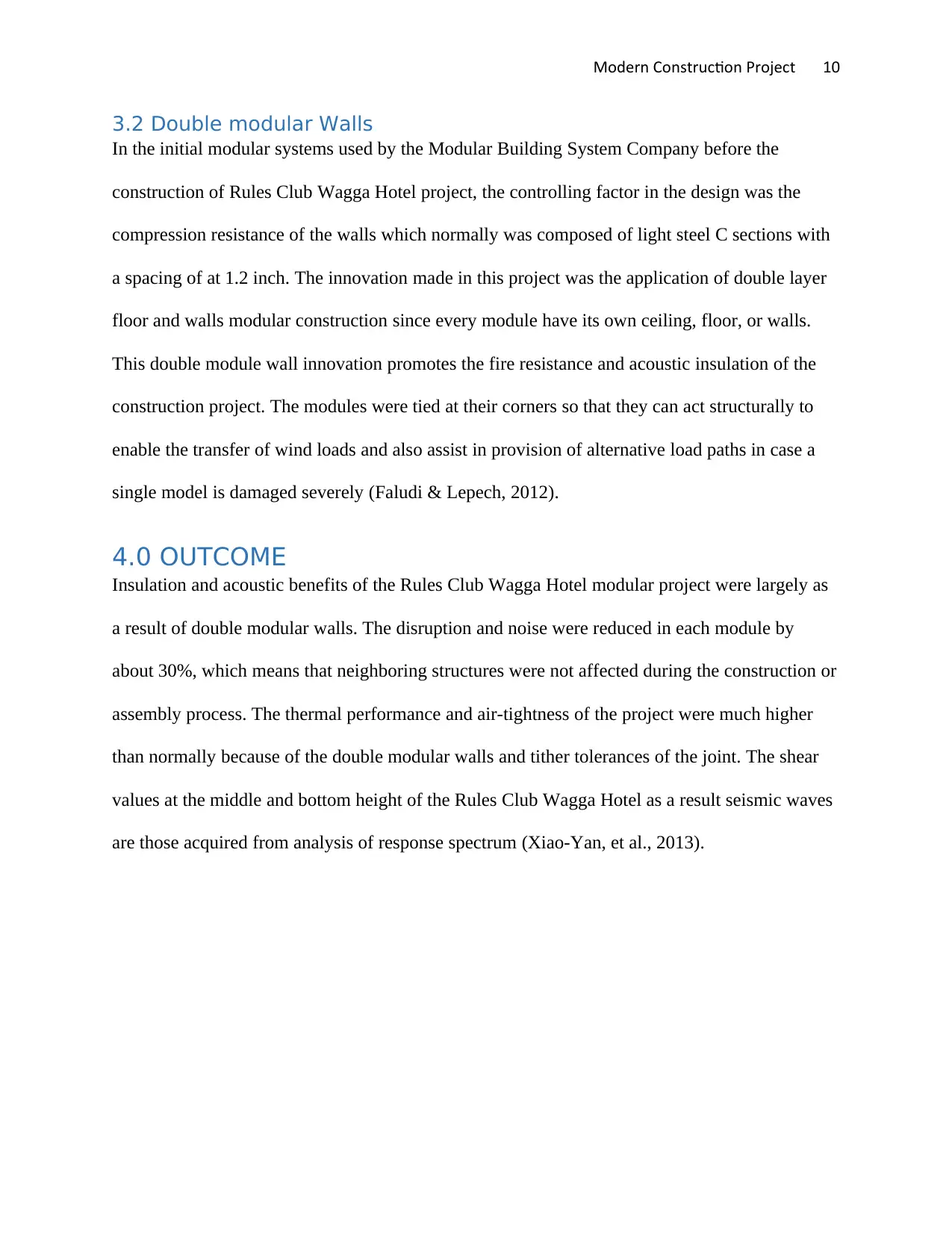
Modern Construction Project 10
3.2 Double modular Walls
In the initial modular systems used by the Modular Building System Company before the
construction of Rules Club Wagga Hotel project, the controlling factor in the design was the
compression resistance of the walls which normally was composed of light steel C sections with
a spacing of at 1.2 inch. The innovation made in this project was the application of double layer
floor and walls modular construction since every module have its own ceiling, floor, or walls.
This double module wall innovation promotes the fire resistance and acoustic insulation of the
construction project. The modules were tied at their corners so that they can act structurally to
enable the transfer of wind loads and also assist in provision of alternative load paths in case a
single model is damaged severely (Faludi & Lepech, 2012).
4.0 OUTCOME
Insulation and acoustic benefits of the Rules Club Wagga Hotel modular project were largely as
a result of double modular walls. The disruption and noise were reduced in each module by
about 30%, which means that neighboring structures were not affected during the construction or
assembly process. The thermal performance and air-tightness of the project were much higher
than normally because of the double modular walls and tither tolerances of the joint. The shear
values at the middle and bottom height of the Rules Club Wagga Hotel as a result seismic waves
are those acquired from analysis of response spectrum (Xiao-Yan, et al., 2013).
3.2 Double modular Walls
In the initial modular systems used by the Modular Building System Company before the
construction of Rules Club Wagga Hotel project, the controlling factor in the design was the
compression resistance of the walls which normally was composed of light steel C sections with
a spacing of at 1.2 inch. The innovation made in this project was the application of double layer
floor and walls modular construction since every module have its own ceiling, floor, or walls.
This double module wall innovation promotes the fire resistance and acoustic insulation of the
construction project. The modules were tied at their corners so that they can act structurally to
enable the transfer of wind loads and also assist in provision of alternative load paths in case a
single model is damaged severely (Faludi & Lepech, 2012).
4.0 OUTCOME
Insulation and acoustic benefits of the Rules Club Wagga Hotel modular project were largely as
a result of double modular walls. The disruption and noise were reduced in each module by
about 30%, which means that neighboring structures were not affected during the construction or
assembly process. The thermal performance and air-tightness of the project were much higher
than normally because of the double modular walls and tither tolerances of the joint. The shear
values at the middle and bottom height of the Rules Club Wagga Hotel as a result seismic waves
are those acquired from analysis of response spectrum (Xiao-Yan, et al., 2013).
Paraphrase This Document
Need a fresh take? Get an instant paraphrase of this document with our AI Paraphraser
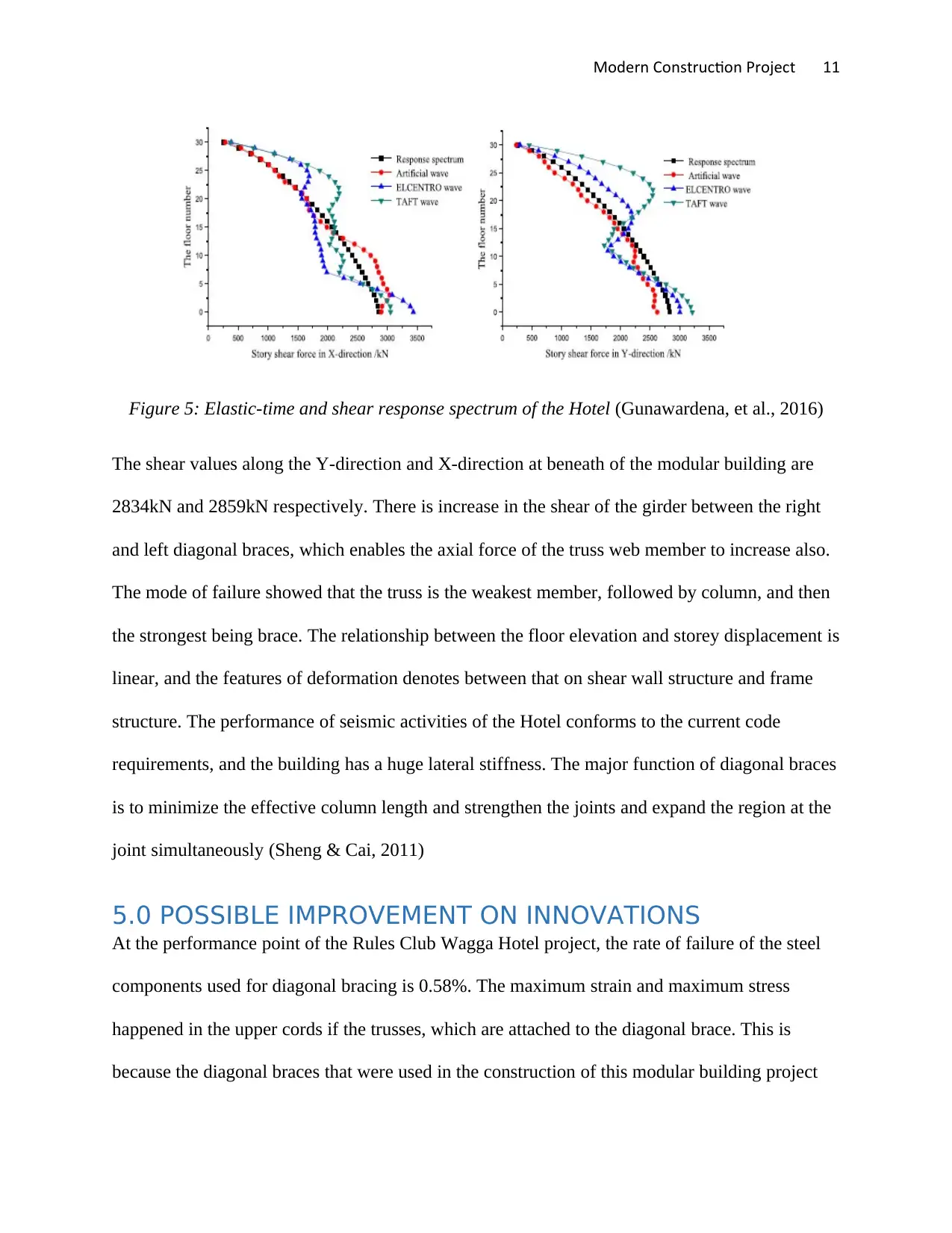
Modern Construction Project 11
Figure 5: Elastic-time and shear response spectrum of the Hotel (Gunawardena, et al., 2016)
The shear values along the Y-direction and X-direction at beneath of the modular building are
2834kN and 2859kN respectively. There is increase in the shear of the girder between the right
and left diagonal braces, which enables the axial force of the truss web member to increase also.
The mode of failure showed that the truss is the weakest member, followed by column, and then
the strongest being brace. The relationship between the floor elevation and storey displacement is
linear, and the features of deformation denotes between that on shear wall structure and frame
structure. The performance of seismic activities of the Hotel conforms to the current code
requirements, and the building has a huge lateral stiffness. The major function of diagonal braces
is to minimize the effective column length and strengthen the joints and expand the region at the
joint simultaneously (Sheng & Cai, 2011)
5.0 POSSIBLE IMPROVEMENT ON INNOVATIONS
At the performance point of the Rules Club Wagga Hotel project, the rate of failure of the steel
components used for diagonal bracing is 0.58%. The maximum strain and maximum stress
happened in the upper cords if the trusses, which are attached to the diagonal brace. This is
because the diagonal braces that were used in the construction of this modular building project
Figure 5: Elastic-time and shear response spectrum of the Hotel (Gunawardena, et al., 2016)
The shear values along the Y-direction and X-direction at beneath of the modular building are
2834kN and 2859kN respectively. There is increase in the shear of the girder between the right
and left diagonal braces, which enables the axial force of the truss web member to increase also.
The mode of failure showed that the truss is the weakest member, followed by column, and then
the strongest being brace. The relationship between the floor elevation and storey displacement is
linear, and the features of deformation denotes between that on shear wall structure and frame
structure. The performance of seismic activities of the Hotel conforms to the current code
requirements, and the building has a huge lateral stiffness. The major function of diagonal braces
is to minimize the effective column length and strengthen the joints and expand the region at the
joint simultaneously (Sheng & Cai, 2011)
5.0 POSSIBLE IMPROVEMENT ON INNOVATIONS
At the performance point of the Rules Club Wagga Hotel project, the rate of failure of the steel
components used for diagonal bracing is 0.58%. The maximum strain and maximum stress
happened in the upper cords if the trusses, which are attached to the diagonal brace. This is
because the diagonal braces that were used in the construction of this modular building project
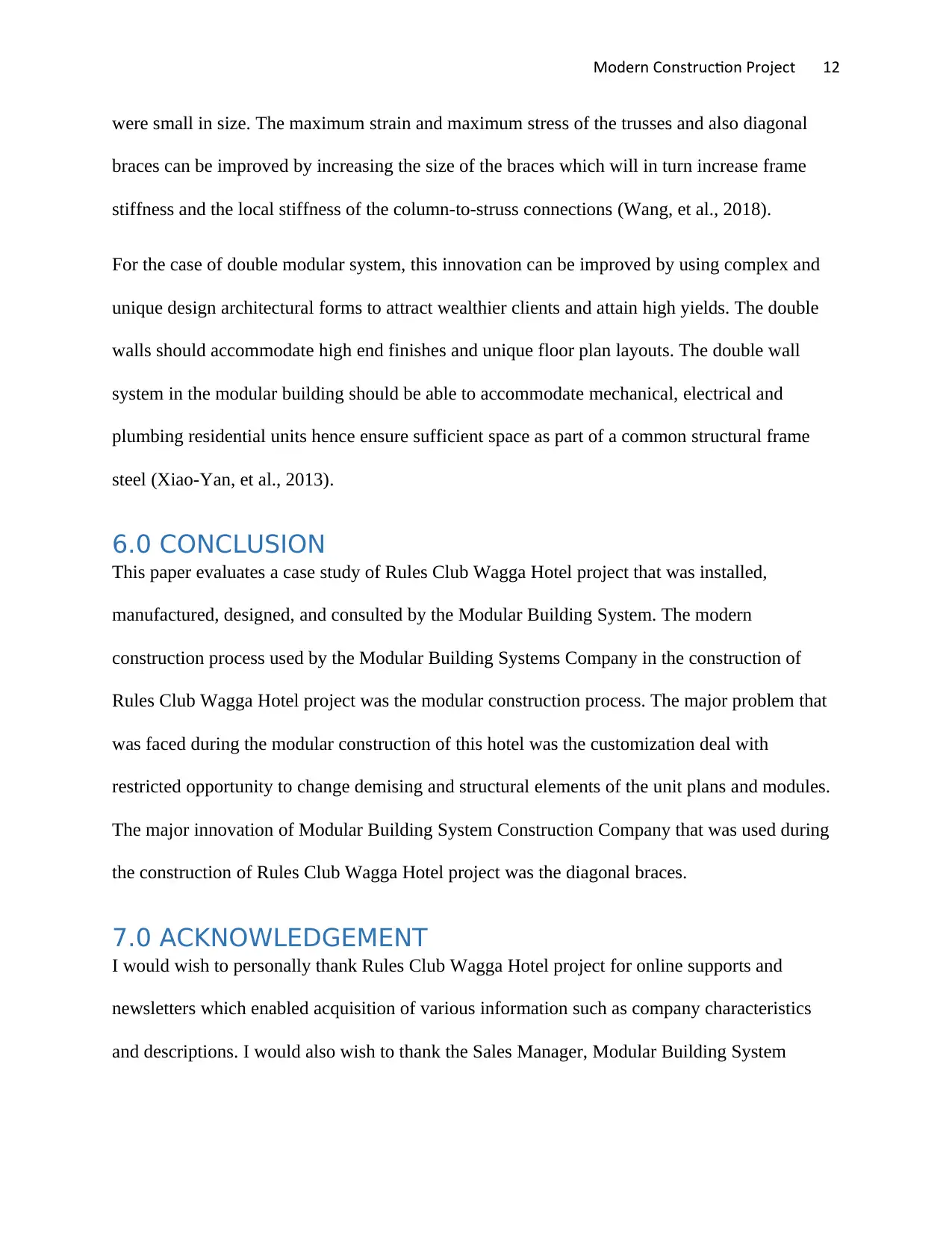
Modern Construction Project 12
were small in size. The maximum strain and maximum stress of the trusses and also diagonal
braces can be improved by increasing the size of the braces which will in turn increase frame
stiffness and the local stiffness of the column-to-struss connections (Wang, et al., 2018).
For the case of double modular system, this innovation can be improved by using complex and
unique design architectural forms to attract wealthier clients and attain high yields. The double
walls should accommodate high end finishes and unique floor plan layouts. The double wall
system in the modular building should be able to accommodate mechanical, electrical and
plumbing residential units hence ensure sufficient space as part of a common structural frame
steel (Xiao-Yan, et al., 2013).
6.0 CONCLUSION
This paper evaluates a case study of Rules Club Wagga Hotel project that was installed,
manufactured, designed, and consulted by the Modular Building System. The modern
construction process used by the Modular Building Systems Company in the construction of
Rules Club Wagga Hotel project was the modular construction process. The major problem that
was faced during the modular construction of this hotel was the customization deal with
restricted opportunity to change demising and structural elements of the unit plans and modules.
The major innovation of Modular Building System Construction Company that was used during
the construction of Rules Club Wagga Hotel project was the diagonal braces.
7.0 ACKNOWLEDGEMENT
I would wish to personally thank Rules Club Wagga Hotel project for online supports and
newsletters which enabled acquisition of various information such as company characteristics
and descriptions. I would also wish to thank the Sales Manager, Modular Building System
were small in size. The maximum strain and maximum stress of the trusses and also diagonal
braces can be improved by increasing the size of the braces which will in turn increase frame
stiffness and the local stiffness of the column-to-struss connections (Wang, et al., 2018).
For the case of double modular system, this innovation can be improved by using complex and
unique design architectural forms to attract wealthier clients and attain high yields. The double
walls should accommodate high end finishes and unique floor plan layouts. The double wall
system in the modular building should be able to accommodate mechanical, electrical and
plumbing residential units hence ensure sufficient space as part of a common structural frame
steel (Xiao-Yan, et al., 2013).
6.0 CONCLUSION
This paper evaluates a case study of Rules Club Wagga Hotel project that was installed,
manufactured, designed, and consulted by the Modular Building System. The modern
construction process used by the Modular Building Systems Company in the construction of
Rules Club Wagga Hotel project was the modular construction process. The major problem that
was faced during the modular construction of this hotel was the customization deal with
restricted opportunity to change demising and structural elements of the unit plans and modules.
The major innovation of Modular Building System Construction Company that was used during
the construction of Rules Club Wagga Hotel project was the diagonal braces.
7.0 ACKNOWLEDGEMENT
I would wish to personally thank Rules Club Wagga Hotel project for online supports and
newsletters which enabled acquisition of various information such as company characteristics
and descriptions. I would also wish to thank the Sales Manager, Modular Building System
⊘ This is a preview!⊘
Do you want full access?
Subscribe today to unlock all pages.

Trusted by 1+ million students worldwide
1 out of 15
Related Documents
Your All-in-One AI-Powered Toolkit for Academic Success.
+13062052269
info@desklib.com
Available 24*7 on WhatsApp / Email
![[object Object]](/_next/static/media/star-bottom.7253800d.svg)
Unlock your academic potential
Copyright © 2020–2025 A2Z Services. All Rights Reserved. Developed and managed by ZUCOL.





